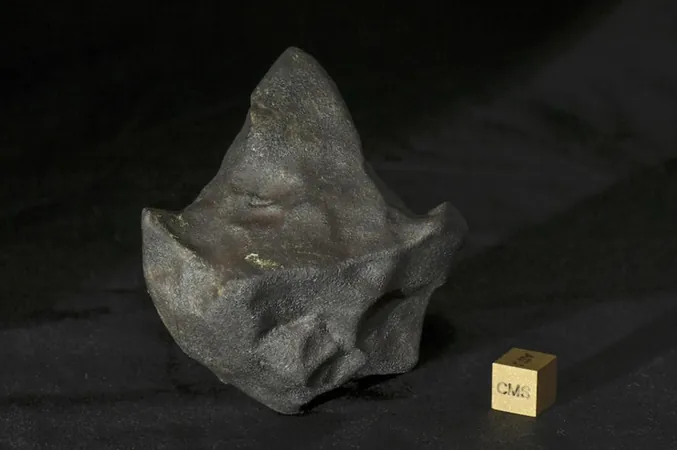
A Cosmic Surprising Discovery: The Resilient Mudball Meteorite of Aguas Zarcas
2025-03-31
Author: Wei Ling
March 31, 2025, Mountain View, CA -- In April 2019, a remarkable event unfolded in the skies above northern Costa Rica as rare primitive meteorites fell in the vicinity of Aguas Zarcas. An international team of researchers recently published their findings in the journal Meteoritics & Planetary Science, revealing that these mudball meteorites defy the common belief that they are fragile.
"We recovered 27 kilograms of meteorite material, marking this as the largest fall of its kind since a similar meteor shower in Murchison, Australia, in 1969," stated meteor astronomer Peter Jenniskens from the SETI Institute and NASA Ames Research Center. This earlier event coincided with a pivotal moment in space exploration, just two months following humanity’s first manned Moon landing.
"The recovery of Aguas Zarcas represents a small step for man, but a giant leap for meteoritics," echoed geologist Gerardo Soto from the University of Costa Rica in San José, paraphrasing Neil Armstrong. The interest surrounding this meteorite is monumental, with 76 scholarly papers written about it in the years following its fall.
The Aguas Zarcas meteorite fall was a sensational event that captured the attention of Costa Ricans. "No other fireball has been as widely reported and recovered in the last 150 years," Soto remarked, underscoring the significance of the incident.
Utilizing high-speed video analysis, the research team discovered that the meteorite entered the Earth’s atmosphere at an impressive speed of 14.6 kilometers per second and from a nearly vertical angle. Although its passage through the atmosphere caused significant melting, little fragmentation was observed, a surprising finding given typical behaviors of such celestial bodies.
"This rock barreled through the atmosphere, shattering at an altitude of 25 kilometers, producing a brilliant flash that was observed by satellites," Jenniskens detailed. Fortuitously, the fall occurred at the close of an extended dry season in Costa Rica, allowing for optimal recovery conditions.
The Aguas Zarcas meteorite presented an incredible diversity of fusion-crusted stones with various shapes, some exhibiting a striking blue iridescence. Researchers noted that many of these stones remained intact upon landing, thanks to the soft jungle and grassy terrain that cushioned their descent.
Often referred to as mudballs due to their water-rich mineral composition, these meteorites have now proven to be more robust than previously thought. Researchers assert that the Aguas Zarcas meteorite's resilience can be attributed to its lack of prior collisions. "The last collision this rock experienced occurred 2 million years ago," remarked cosmochemist Kees Welten of UC Berkeley, adding that it was crucial for the rock to avoid cracks that typically weaken meteorites.
After breaking away from a larger asteroid, this meteorite would have spent eons in space, finally making its way to Earth. "We know there are other Murchison-like meteorites that became detached around the same time, yet most have fragmented more recently," Welten noted.
Initially measuring around 60 centimeters in diameter, the meteorite’s trajectory through the atmosphere revealed its origins from the outer regions of the asteroid belt. "It’s incredible to think that this object evaded damage for two million years before reaching the tiny target that is Earth," said Jenniskens.
Because it entered the atmosphere at a steep angle, a significant portion of the meteorite's mass survived the journey, making this discovery not only scientifically intriguing but also a fascinating tale of cosmic endurance. The findings challenge existing notions about mudball meteorites and open new avenues for research in meteoritics.
This exceptional event and its implications continue to resonate within the scientific community, with more studies on these celestial travelers anticipated in the years to come.




 Brasil (PT)
Brasil (PT)
 Canada (EN)
Canada (EN)
 Chile (ES)
Chile (ES)
 Česko (CS)
Česko (CS)
 대한민국 (KO)
대한민국 (KO)
 España (ES)
España (ES)
 France (FR)
France (FR)
 Hong Kong (EN)
Hong Kong (EN)
 Italia (IT)
Italia (IT)
 日本 (JA)
日本 (JA)
 Magyarország (HU)
Magyarország (HU)
 Norge (NO)
Norge (NO)
 Polska (PL)
Polska (PL)
 Schweiz (DE)
Schweiz (DE)
 Singapore (EN)
Singapore (EN)
 Sverige (SV)
Sverige (SV)
 Suomi (FI)
Suomi (FI)
 Türkiye (TR)
Türkiye (TR)
 الإمارات العربية المتحدة (AR)
الإمارات العربية المتحدة (AR)